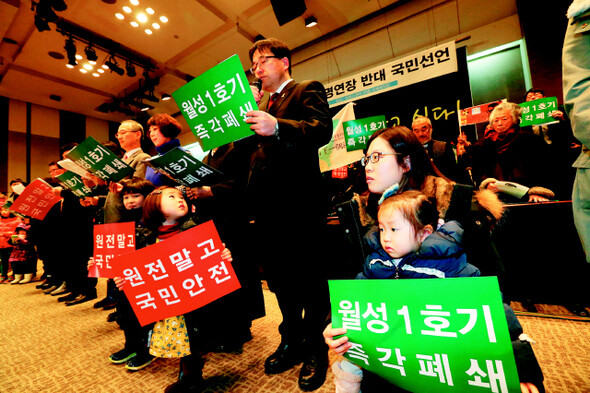hankyoreh
Links to other country sites 다른 나라 사이트 링크
Report: electricity supply could be maintained without outdated Wolseong and Kori reactors

According to a Feb. 9 report published by the National Assembly Budget Office (NAB), even if Wolseong No. 1 and Kori No. 1 nuclear reactors are decommissioned at the end of their designed lifespan, South Korea is projected to have a stable supply of electricity through 2025.
On Monday, the budget office released a preliminary assessment of the government’s basic plan for supplying electric power, addressing some of the contentious claims in the plan.
The 7th Power Supply Plan, prepared by the Ministry of Trade, Industry and Energy, defines South Korea’s power generation goals through 2029.
“Even in the event that Wolseong No. 1 and Kori No. 1 are shut down, the installed reserve rate will exceed 20% through 2025. Consequently, the question of whether to continue operating these reactors, which would require an extension of their lifespan, would have little effect on the stability of the power supply,” the budget office projected in its report.
There are a number of reasons for this. First, the reactors that were planned in the 6th Power Supply Plan will be coming online around 2021, boosting the installed reserve rate and thus leading to a surplus in the power supply. Second, the economy has been growing more slowly than expected while the price of electricity has been increasing, which is expected to curb demand for (and hence consumption of) electricity.
Based on these projections, Justice Party lawmaker Kim Je-nam analyzed what would happen if Wolseong No. 1 and Kori No. 1 were decommissioned in the first half of 2015 and the first half of 2017, respectively.
“According to my analysis, the installed reserve rate could be maintained between 18.5% and 21.0% through 2027, which is higher than the ideal reserve rate of 15%,” Kim said.
The installed reserve rate refers to the percentage of generation capacity held in reserve above the maximum power demand projected during a given year. When the reserve rate increases, power generators should be shut down to keep the rate at the ideal level.
Generally speaking, 15% is regarded as a safe rate.
“The government‘s claim that extending the lifespan of the aging nuclear reactors is essential for the power supply is a obvious lie. The government should shut down Wolseong No. 1 immediately and stop provoking unnecessary arguments about extending its lifespan,” Kim said.
In related news, with the Nuclear Safety and Security Commission (NSSC) scheduled to review a proposal to extend the lifespan of Wolseong No. 1 only three days later, press conferences were held simultaneously on Monday morning in Seoul and other major cities around the country in opposition to the proposal. The conferences were planned by environmental organizations and other civic groups, with religious leaders, academics, cultural figures, and ordinary citizens taking part.
A conference at the Press Center in central Seoul was organized by a number of environmental groups including Joint Action for a Nuclear-Free Society, Friends of the Earth Korea, and Green Korea.
“Now that Wolseong No. 1’s lifespan is over, decommissioning it is the first step toward keeping us safe. We strongly urge the Nuclear Safety and Security Commission to respect public wishes by making the wise decision,” the groups said.
By Lee Seung-joon, staff reporter
Please direct questions or comments to [english@hani.co.kr]

Editorial・opinion
![[Guest essay] The real reason Korea’s new right wants to dub Rhee a founding father [Guest essay] The real reason Korea’s new right wants to dub Rhee a founding father](https://flexible.img.hani.co.kr/flexible/normal/500/300/imgdb/original/2024/0423/8317138574257878.jpg) [Guest essay] The real reason Korea’s new right wants to dub Rhee a founding father
[Guest essay] The real reason Korea’s new right wants to dub Rhee a founding father![[Column] ‘Choson’: Is it time we start referring to N. Korea in its own terms? [Column] ‘Choson’: Is it time we start referring to N. Korea in its own terms?](https://flexible.img.hani.co.kr/flexible/normal/500/300/imgdb/original/2024/0423/3617138579390322.jpg) [Column] ‘Choson’: Is it time we start referring to N. Korea in its own terms?
[Column] ‘Choson’: Is it time we start referring to N. Korea in its own terms?- [Editorial] Japan’s rewriting of history with Korea has gone too far
- [Column] The president’s questionable capacity for dialogue
- [Column] Are chaebol firms just pizza pies for families to divvy up as they please?
- [Column] Has Korea, too, crossed the Rubicon on China?
- [Correspondent’s column] In Japan’s alliance with US, echoes of its past alliances with UK
- [Editorial] Does Yoon think the Korean public is wrong?
- [Editorial] As it bolsters its alliance with US, Japan must be accountable for past
- [Guest essay] Amending the Constitution is Yoon’s key to leaving office in public’s good graces
Most viewed articles
- 1[Column] ‘Choson’: Is it time we start referring to N. Korea in its own terms?
- 2Senior doctors cut hours, prepare to resign as government refuses to scrap medical reform plan
- 3[Guest essay] The real reason Korea’s new right wants to dub Rhee a founding father
- 4Why Korea shouldn’t welcome Japan’s newly beefed up defense cooperation with US
- 5[Column] The clock is ticking for Korea’s first lady
- 6Opposition calls Yoon’s chief of staff appointment a ‘slap in the face’
- 7New AI-based translation tools make their way into everyday life in Korea
- 8Terry Anderson, AP reporter who informed world of massacre in Gwangju, dies at 76
- 9Korean government’s compromise plan for medical reform swiftly rejected by doctors
- 10[Editorial] Japan’s rewriting of history with Korea has gone too far